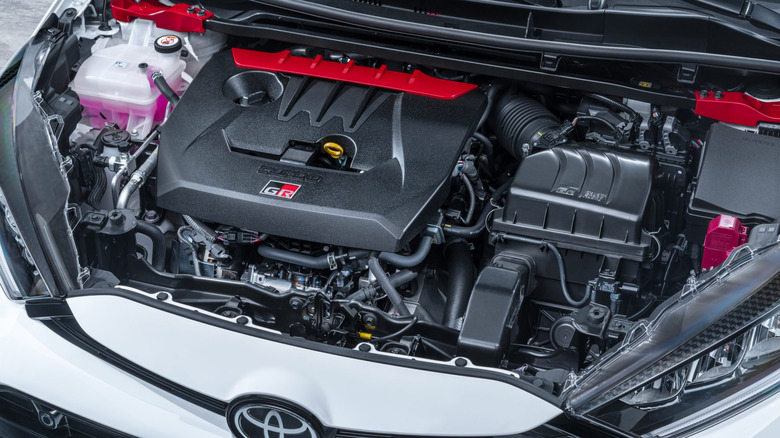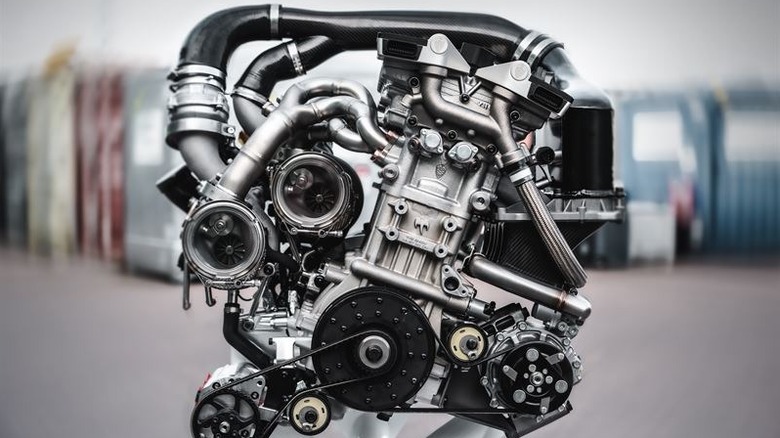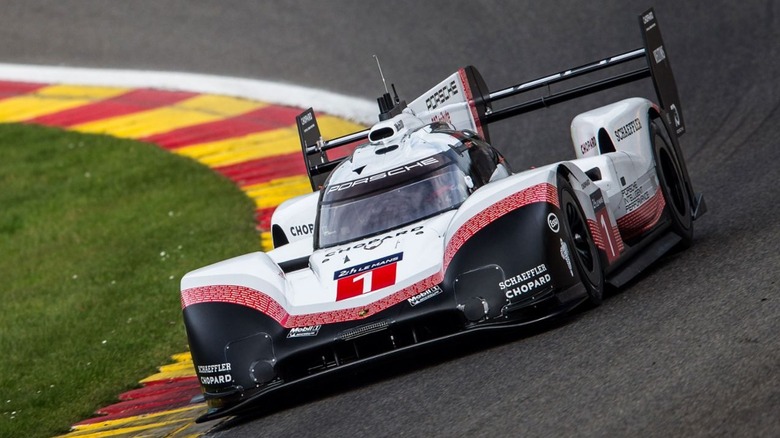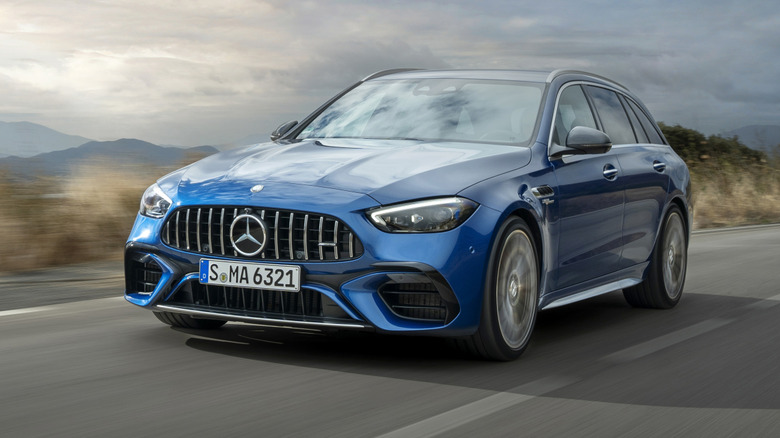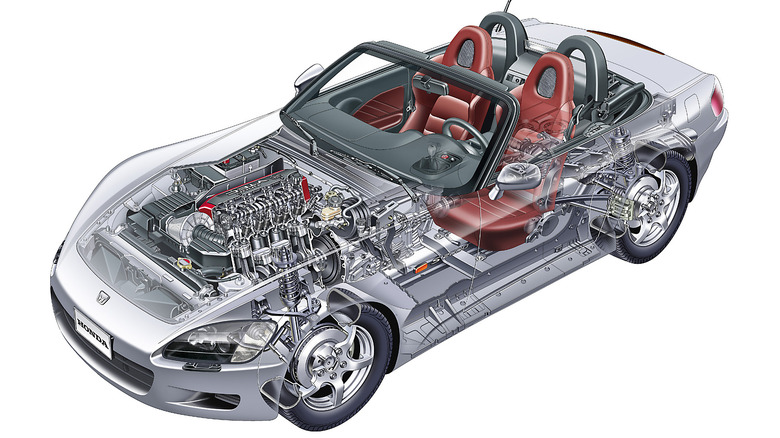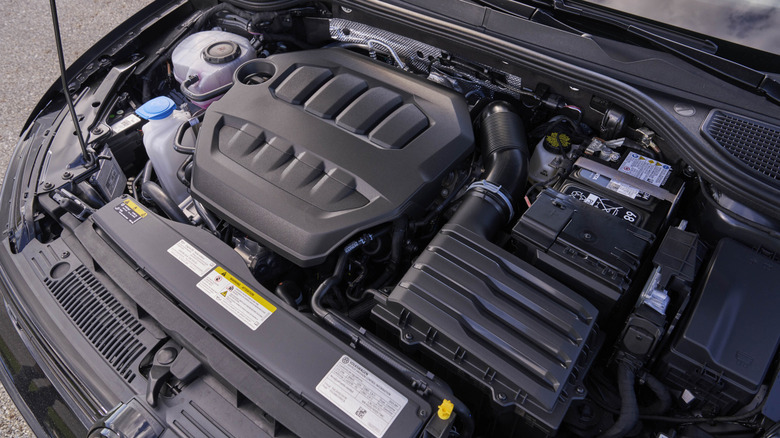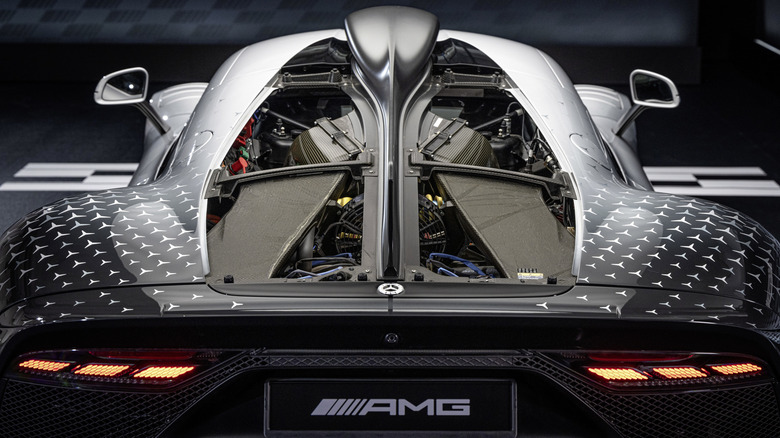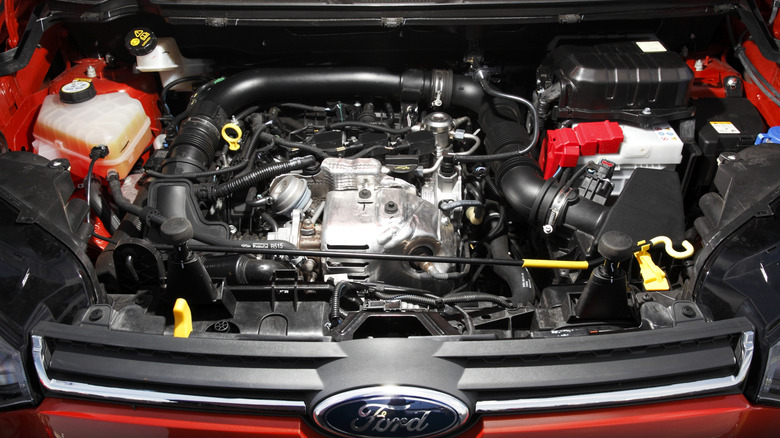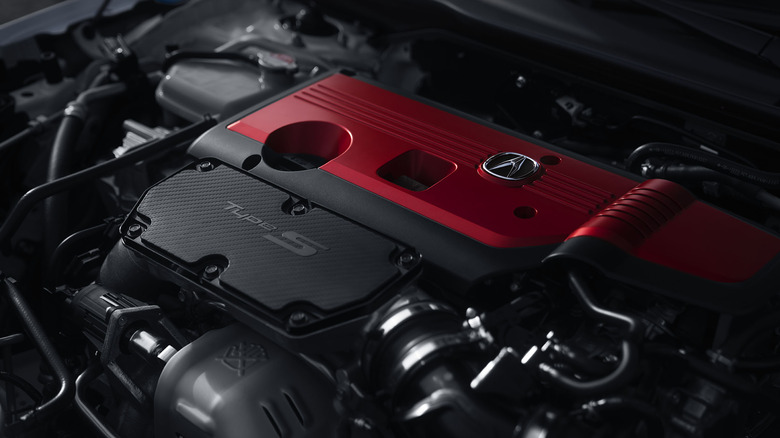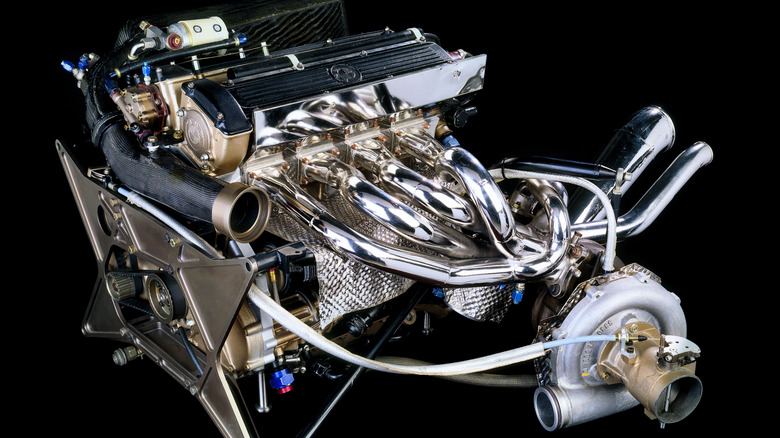13 Tiny Car Engines With Unexpectedly Impressive Horsepower
Traditionally, in engine building, high displacement and high horsepower figures go hand in hand. You've probably heard the phrase, "there's no replacement for displacement." While that might have been true decades ago, in performance terms, displacement has arguably never made less of a difference than it does today. Sure, enthusiasts might argue that a gas-guzzling, rumbling V8 engine has a soundtrack that a four- or three-cylinder could never hope to match. However, in pure horsepower terms, tiny engines now punch well above their weight on road and track.
It isn't uncommon for modern road car engines with less than 2.0 liters of displacement to boast outputs of 300 horsepower or more, with some even offering well over 400 horsepower. Racing engines of a similar size can boast even crazier outputs, churning out vast amounts of ponies while still being durable and reliable enough to withstand the demands of the world's toughest motorsport events. These 13 engines from both road and race cars all offer higher horsepower outputs than you might think, given their tiny size, with many of them available for discerning enthusiasts to buy today.
Toyota G16E-GTS
After returning to the top level of competition in 2017, Toyota has seen a run of success in the World Rally Championship, racking up five consecutive drivers' titles between 2019 and 2023 and four manufacturers' titles between 2021 and 2024. The expertise gleaned from competition has been transferred into the manufacturer's road cars, most notably to the GR Yaris and GR Corolla, which directly borrow technology from the WRC efforts.
The GR Yaris was the first to arrive, being an adaptation of a competition car scheduled for the 2020 season that ended up being axed. Thankfully, Toyota decided that the roadgoing version of the car would be produced anyway, even if the brand decided to stick with its older competition-spec car for a couple of extra seasons. It was followed up by the GR Corolla, which was created as a way to appeal to markets like North America, where the Yaris was simply too small to sell well. Both variations have proved to be a huge success for Toyota, with the brand even announcing that it was opening a second production line in the U.K. to cater to the growing GR Corolla demand.
Both the GR Corolla and GR Yaris feature the G16E-GTS, a 1.6-liter three-cylinder engine that makes up to 300 horsepower. Its forged internals, hydro-lock resistant air intake, and beefy turbocharger are all evidence of its rallying pedigree, while its competition-derived all-wheel drive system ensures that its power hits the ground at all four corners like a true rally champion.
Koenigsegg TFG
Originally developed for the Gemera but later shelved due to a lack of demand, the Koenigsegg TFG engine remains in prototype-only form for now. It was originally offered as an option for the four-seater hypercar with an output of up to 600 horsepower, depending on the fuel used. The TFG, or "Tiny Friendly Giant," is a 2.0-liter three-cylinder engine that, in typical Koenigsegg fashion, is unlike any other engine on the market.
It uses a camless design developed by Koenigsegg's sister company, Freevalve, with each valve able to open and close independently depending upon the driving situation. Each cylinder has two valves, one for the engine's larger turbocharger and the other for the smaller turbocharger. Only the valve for the smaller turbo opens at lower speeds, resulting in a faster throttle response. But when drivers put their foot to the floor, the valve for the larger turbo opens up, allowing it to spool up and provide maximum boost.
Koenigsegg first unveiled the engine more than half a decade ago, but in 2024, the company announced that most Gemera buyers had chosen the optional V8 engine. Perhaps that's not a surprise, since the hybrid three-cylinder powertrain had a total output of around 1,700 horsepower while the hybrid V8 boasted a staggering 2,269 horsepower. Buyers picked the more powerful option, and that currently leaves Koenigsegg's Tiny Friendly Giant without a path to production.
Porsche 919 Hybrid Evo V4
The car with the outright record at the Nürburgring Nordschleife is not a V8-powered hypercar nor a V12 exotic, but a four-cylinder hybrid. Of course, it's no ordinary four-cylinder hybrid — it's an extensively modified version of the Le Mans-winning Porsche 919 Hybrid race car, with a total system output of 1,160 horsepower. The car's 2.0L V4 engine is responsible for a whopping 720 horsepower of that output. It's a derestricted version of the engine in the Le Mans car, with the 919 Hybrid Evo designed specifically as a record-setting one-off prototype. When it was subject to the rules of the World Endurance Championship, it made around 500 horsepower.
To handle the additional power, Porsche redesigned the 919 Hybrid's aero package for significantly increased downforce and created unique tires for the car in collaboration with Michelin. The result comfortably smashed the previous 'Ring record, clocking a time of 5:19.55 with former WEC champion Timo Bernhard at the wheel. Porsche secretly considered creating a road-legal version of the 919 Hybrid, complete with its original powertrain, and even went as far as creating a clay model of what it might look like. However, it never made production.
Mercedes-Benz M139
The M139 engine can be found in a variety of Mercedes-Benz models, but it's at its most powerful in the Mercedes-AMG C63 S E Performance. It churns out 469 horsepower supplemented by electric power for a combined powertrain output of 671 horsepower. That's enough to make the C63 faster than its predecessor on paper, but it hasn't been enough to make the car an appealing choice among enthusiasts.
In June 2025, an unnamed senior source at the automaker told Autocar that the C63's 2.0-liter four-cylinder powertrain would be replaced with a six-cylinder or eight-cylinder engine for its next generation. According to the source, the four-cylinder has simply "failed to resonate with [AMG's] traditional customers," even though "there's no doubt about its potential [since] this is one of the most sophisticated engines we've ever built." Sophisticated or not, the M139 is set to be phased out in the near future, with AMG focusing on larger engines to win back buyers who found the four-cylinder to lack the character of the older V8 engines.
Honda F20C
A 2.0-liter four-cylinder engine with an output of 247 horsepower doesn't sound particularly unusual today. However, unlike most high-powered four-cylinder engines, Honda's F20C did not feature a turbocharger or a supercharger, instead being naturally aspirated. At the time of its unveiling, it had the highest horsepower-per-liter output of any production naturally aspirated engine, beating everything from Italian exotics to German autobahn rockets. The engine was also developed more than a quarter of a century ago, and first launched for sale in 1999.
The F20C is one of the most technically impressive engines in Honda's F-Series line, but its development was far from straightforward. Honda noted that, during its early development, the engine would break every time it was fired up, often causing significant damage to its components in the process. By designing forged pistons and tweaking a slew of smaller elements of the engine's design, such as changing the piston pin offset, Honda's engineers slowly eliminated the engine's reliability woes. Their perseverance paid off, as the F20C is now considered to be one of the most reliable Honda engines if it's properly maintained.
Caterham Ford Duratec 2.0L
The Caterham Seven doesn't need a particularly powerful engine to make it feel fast, since it's so low-slung and lightweight. However, that hasn't stopped Caterham from offering one anyway. The Seven 620 is the brand's fastest production road car, and under its hood sits a 2.0-liter Ford Duratec engine that's been tweaked by the British car brand. It's also been fitted with a supercharger, which results in a power output of 310 horsepower.
That already makes it one of the most powerful four-cylinder engines of its size in production, but in a stripped-back Seven it will feel even faster. The Seven 620 weighs just 1,345 pounds, and there are no doors or a roof to protect drivers from the elements. It launches from 0-60 mph in 2.8 seconds on its way to a top speed of 149 mph — which, in a Caterham, will feel an awful lot faster than in most other cars.
Aside from appearing in the Caterham, the Duratec 2.0-liter engine can also be found under the hood of a range of more everyday cars. In detuned form, it has been offered in Euro-market models, including the Focus, C-Max, and the EcoSport.
Volkswagen EA888
The EA888 engine is a long-running Volkswagen product, having been in production in various forms for almost two decades. Over that time, the German automaker has continuously improved its design, with the latest iteration of the EA888 engine making an impressive amount of horsepower given its modest size. It appears in a variety of popular Volkswagen models, but it's at its most powerful in the 2025 Golf R. There, it produces 328 horsepower, despite a diminutive displacement of 2.0 liters.
The 2025 Golf R engine is a fourth-generation EA888 engine and relies on a turbocharger and direct injection to achieve its power output. The 2025 model year is the most powerful series-production Golf R to date, eclipsing the previous model year by around 13 horsepower. It matches the 328 horsepower (or 333 metric horsepower) achieved by the Golf R 333 Limited Edition that was unveiled in 2023, which is one of the rarest Volkswagens ever made.
Mercedes-AMG One 1.6L
The phrase "race car for the road" is a common one in automotive discourse, but few cars claim to embody the phrase as literally as the Mercedes-AMG One. The ultra-limited hypercar takes its powertrain from the 2016 Mercedes F1 car, with its 1.6-liter V6 engine carried over mostly unchanged. However, it isn't identical to the PU106C engine that appeared in the F1 car, with engineers making a number of changes to boost its durability. These changes included designing a new fuel injection system, altering the airflow, and fitting filters and catalysts to allow the engine to meet road emissions regulations.
It was also adjusted to have a lower idle than an F1 car, both to improve emissions and to make it quieter at everyday speeds. One thing that wasn't significantly changed was the engine's power output, which stands at 574 horsepower. Coupled with the electric motors, the powertrain produces a combined output of 1,063 horsepower. AMG says that buyers can expect the engine to last around 31,000 kilometers before reaching the end of its life. While that's more than a typical F1 engine, it's still far shorter than almost any other road car. Those 31,000 kilometers can potentially be covered in record time, too, since the Mercedes-AMG One is the fastest production AMG to leave the factory to date.
Ford 1.0L EcoBoost
An output of 138 horsepower seems modest compared to the other engines here until you realize that it comes from a 1.0-liter three-cylinder engine. Ford's 1.0L EcoBoost was available in a range of Euro-market cars, but it was at its most powerful in the Ford Fiesta Red Edition and Black Edition. Its power output meant that it offered more horsepower per liter than a Bugatti Veyron, yet it also achieved up to 62.8 mpg according to Ford's estimates.
The brand noted that the cast iron block of the engine was small enough to fit in the overhead compartment of a commercial airliner, and that several design innovations, including a unique flywheel and coated pistons, helped it achieve its power. Ford also offered the engine in various other European models, including the Focus hatchback, EcoSport crossover, and Mondeo sedan. Unfortunately, the 1.0L EcoBoost has had its fair share of reliability problems, and so keeping one running strong will require careful maintenance.
Nissan Zeod RC DIG-T R 1.5L
Alongside its regular competitors, the 24 Hours of Le Mans also sometimes includes a "Garage 56" entry for an experimental prototype to take part in the race. In 2014, it was the turn of the Nissan Zeod RC to take part, 2 years after the infamous Nissan DeltaWing prototype was given a shot at completing the race. Neither the DeltaWing nor the Zeod RC completed the full 24 hours, but the Zeod RC's powertrain is notable nonetheless. Alongside electric motors, the prototype featured a 1.5-liter three-cylinder DIG-T R engine that weighed just 88 pounds but produced 400 horsepower. To demonstrate its light weight, NISMO President Shoichi Miyatani even picked up the entire engine for a photoshoot.
The engine functioned as intended during its stint at Le Mans, but the Zeod RC's race was brought to a halt thanks to a fault with the transmission. Nissan already made production three-cylinder engines, including the HR12DE, at the time of the Zeod RC's debut, but nothing that was anywhere near as powerful as the DIG-T R. In the end, Nissan chose not to develop the hybrid three-cylinder powertrain further, with its endurance car for the 2015 season featuring a more traditional V6 engine.
Honda K20C
Honda's K20 engine can be found powering everything from the Civic to the Accord, but the most powerful version sits under the hood of the Acura Integra Type S. The 2.0-liter K20C four-cylinder offers 320 horsepower, making it the most powerful car to wear the Integra nameplate. It's also impressively low-maintenance considering its performance credentials, with Acura claiming that it needs no scheduled maintenance aside from regular fluid and filter changes for at least 100,000 miles.
As well as packing Honda's well-known VTEC, the K20C also features cylinder heads with integrated ports, eliminating the need for a separate manifold. A direct injection system helps balance efficiency and power, while the pistons are coated in molybdenum to reduce friction. Combined with the many other small improvements made to the engine, it leaves the K20C with an output that's ample for driving thrills with the reliability and durability that Acura buyers have come to expect from the brand.
Volvo B4204T48
Volvo might not be the first brand that springs to mind when thinking of high performance, but its cars can be deceptively fast. Volvo engines even power some supercars, including the 650-horsepower Noble M600 that borrows its engine from the XC90 SUV. The B4204T48 2.0-liter four-cylinder engine can't hit those kinds of horsepower numbers, but in the Polestar 1, it achieves an impressive 326 horsepower. Polestar began as a Swedish race team that competed using Volvo touring cars before being eventually acquired by the automaker itself. It later became Volvo's performance arm before spinning off as a standalone brand, with the Polestar 1 being the first unique model.
The B4204T48 engine can also be found in certain Polestar Engineered Volvo models like the XC60 Recharge Polestar Engineered, but in the Polestar 1, it was given some additional tweaks. It was both supercharged and turbocharged, and then it was paired with a trio of powerful electric motors for a combined powertrain output of over 600 horsepower. The 1 was released in limited numbers and is, to date, the only car from the standalone Polestar brand to feature a combustion engine, since the rest of its range is made up of all-electric models.
BMW M12/13
Ultra-powerful four-cylinder engines are not a new phenomenon. In fact, the engine that can credibly lay claim to being the most powerful four-cylinder ever created made its race debut in 1982. That engine was the BMW M12/13, and it was so powerful that testing equipment at the time couldn't accurately measure its power output. According to BMW, it sat somewhere around 1,400 horsepower. That output wasn't always deployed — in race conditions, engineers detuned the engine for better reliability. However, in qualifying, drivers had the engine's full power at their disposal.
What's even more remarkable is that the engine had only 1.5 liters of displacement from which to develop its four-figure power output. Unsurprisingly, a turbocharger was a key element of achieving that power. As well as being immensely powerful, the engine proved to be resilient enough to win races, with Nelson Piquet using a BMW-equipped Brabham BT52 to claim the F1 drivers' title in 1983.

